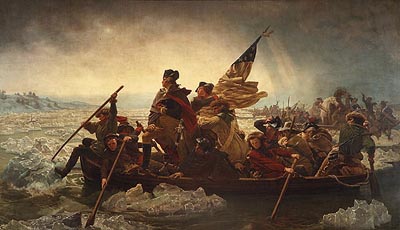|
FRESH STUFF DAILY |
|
|
||
|
|
||
|
|
||
|
SEE ALL SIGNED BOOKS by J. Dennis Robinson click here |
||
Page 3 of 4
"Washington Crossing the Delaware" Emanuel Leutze was born in Germany, and like Sully, came to America with his parents at an early age. They settled in Philadelphia where Sully was a well-known portrait artist, but Leutze spent half his life abroad. Trained in Dusseldorf, famous for its fine painting school, Leutze perfected the grand detailed historical painting style focusing first on tableaux featuring Christopher Columbus. The story of his most famous and familiar work, "Washington Crossing the Delaware" plays like a TV mini-series. Like Sully, Leutze painted from live models and struggled for the utmost accuracy. A friend who posed for the body of Washington noted that the artist used almost exclusively Americans visiting in Germany in order to get accurate features. Unfortunately, details of costume, boat and weather conditions are not as recorded by history. The painting was nearly complete in Dusseldorf, when it was damaged by a fire in the studio. Though badly torn, the original was repaired and exhibited and eventually destroyed by Allied bombing of Germany in World War II. The second image, the one now hanging in the Metropolitan Museum of Art in New York, was painted in a large hall where Leutze and five other artists worked. Leutze's gigantic 20 by 16-foot canvas allowed for life-sized figures. A visitor to the hall noted that there was always a keg of beer behind the canvas and "a disposition to be jolly". The painters were so jolly, according to the account, that they purchased small cannons that they fired frequently, even shooting bullets until the inner walls of the German hall that was "fearfully scarred." Plans to tour the painting in America proved successful as 50,000 visitors paid to see the work in New York late that same year. It was sold for $10,000 and exhibited in the Capitol Rotunda in Washington, DC. That success led Leutze to petition the US Congress in 1852 to paint a companion piece for the Capitol. It was more than a decade before his received a commission, but the popular subject this time was "Westward Ho," depicting America's westward expansion by wagon train. In her detailed essay on the painting for the Met ("American Painting in the Metropolitan Museum of Art"), writer Natalie Spasskey says the painting has gained a status nearly equivalent to a national monument. It has been copied, printed and exhibited continuously for nearly 150 years and the classic image shows no sign of losing favor. Spasskey accepted Sidney Kaplan's theory that the African-American depicted is Prince Whipple of Portsmouth, NH. Continue with PRINCE WHIPPLE Please visit these SeacoastNH.com ad partners.
News about Portsmouth from Fosters.com |
| Friday, April 26, 2024 |


|
Copyright ® 1996-2020 SeacoastNH.com. All rights reserved. Privacy Statement
Site maintained by ad-cetera graphics

 Stories
Stories



















